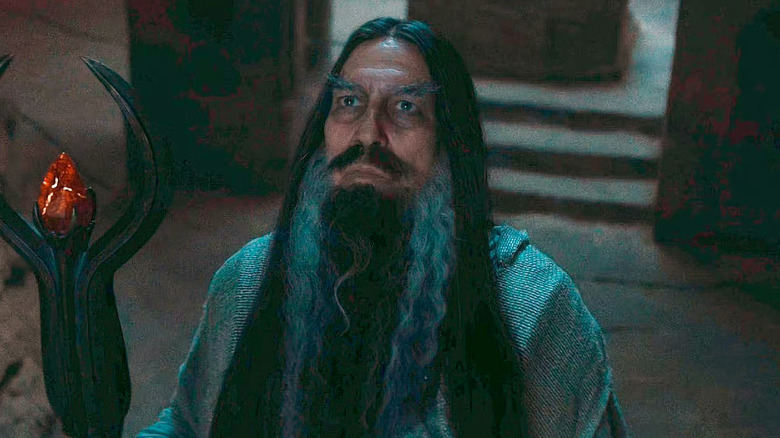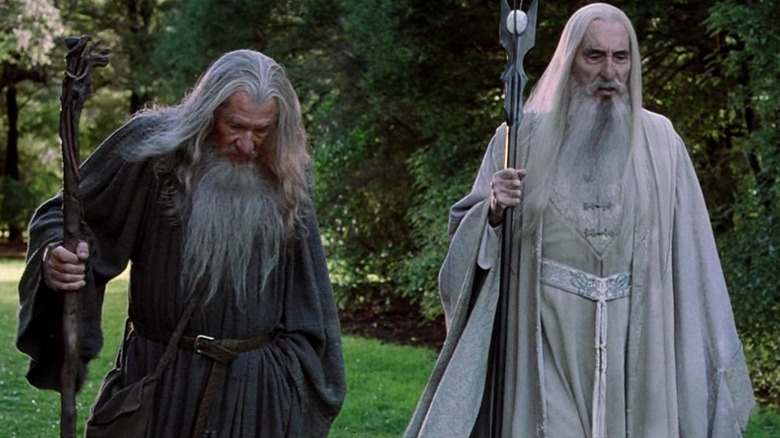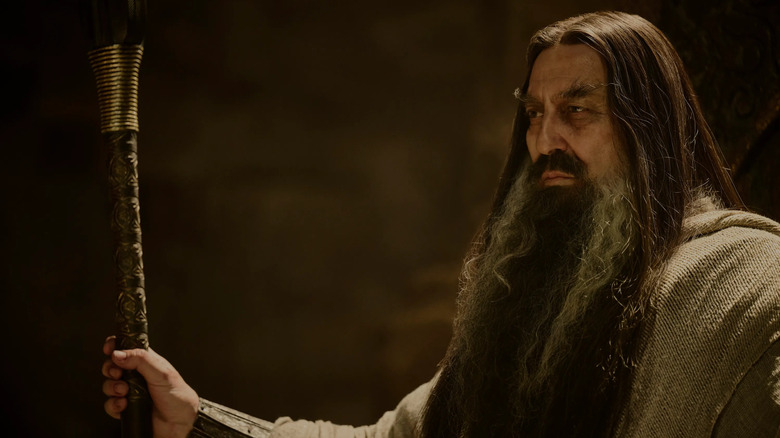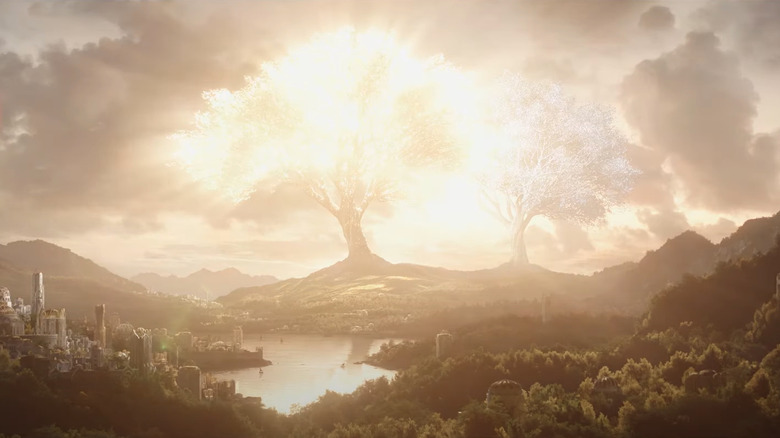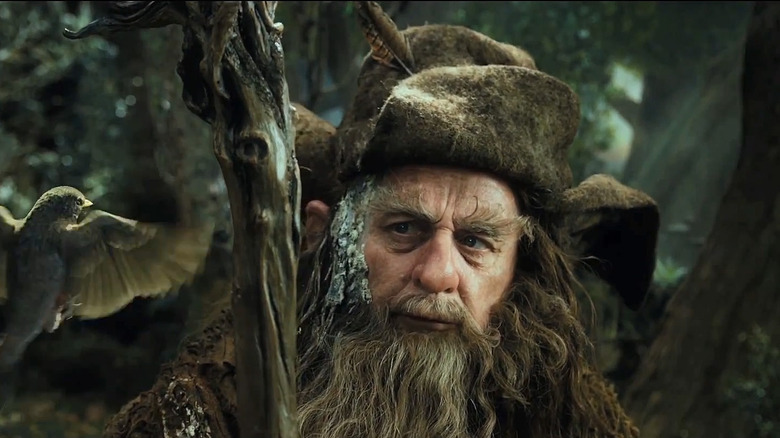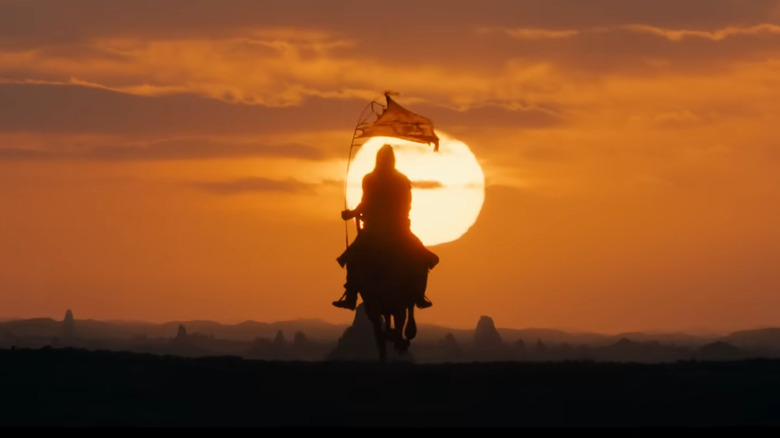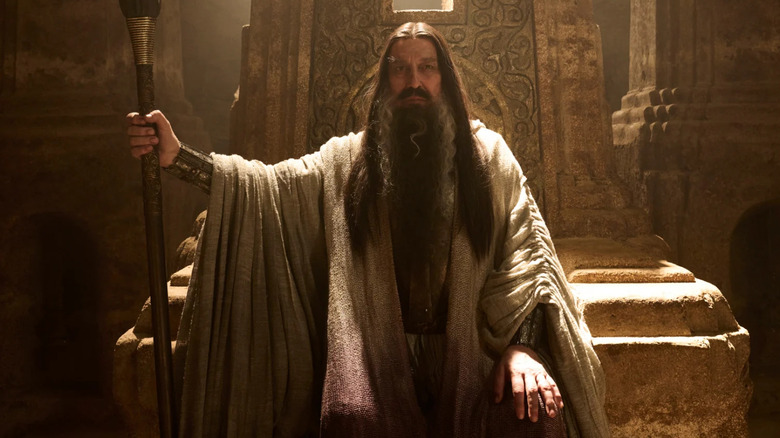The Rings Of Power: Who Is The Dark Wizard?
When "The Lord of the Rings: The Rings of Power" Season 2 aired in late 2024, a smorgasbord of new faces joined the Second Age story. Some of these were classic canon characters, like Tom Bombadil and a younger version of Shelob. Others were brand-new inventions. And then there were the semi-canon characters who might be connected to the source material: In Season 1, Halbrand (Charlie Vickers) is in this category until he is revealed to be Sauron in disguise. Season 2 follows the same tactic with Daniel Weyman's The Stranger — until he is confirmed as Gandalf in the finale.
As we move toward a now-greenlit Season 3, one character remains trapped in the limbo of the unknown more than any other: the Dark Wizard. This being might be one of J.R.R. Tolkien's two Blue Wizards, the less likely choice of Radagast the Brown, or another option. However, the magic-wielding Eastern leader, played by the talented Ciarán Hinds, remained unnamed when the finale end credits rolled. Everyone simply referred to him as "the Dark Wizard."
As far as the Dark Wizard directly correlating to a character in the author's writings, there is none. Tolkien certainly created characters like Saruman, who were "dark" in their behavior, and darkness is often associated with other evil things in his writings too. Orcs like the dark. Sauron is called the Dark Lord and covers the skies with darkness before attacking Minas Tirith in "The Lord of the Rings." Even the Dwarves like the dark. In "The Hobbit," they quite literally tell Bilbo, "We like the dark [...] dark for dark business!" The one thing the Oxford professor didn't write about, though, was a Dark Wizard. Who is he, then? Let's break down our options.
Who isn't the Dark Wizard?
Let's first consider who the Dark Wizard isn't. The biggest surprise so far, which addresses the elephant in the room for most fans, is that he is not Saruman. In the source material, Saruman does go to the Eastern regions of the world multiple times. Add the fact that the Dark Wizard is squaring off against a young Gandalf, and even looks a bit like Saruman (note the black in his beard), and it all seems to make sense. Except that, when you dig a little deeper, the theory comes off the rails.
Saruman ultimately does betray Gandalf and his friends during "The Lord of the Rings," but what makes this so dramatic is that, up until then, he has had their deep trust, cultivated over centuries of alliance and collaboration. This wouldn't work if Prime Video added a Dark Wizard version of Saruman to face Gandalf thousands of years earlier. It would just turn their "Lord of the Rings" story into an awkward "fool me once, fool me twice" scenario.
Even more damning to the Saruman theory? Showrunners Patrick McKay and J.D. Payne have all but definitively said that this is a non-starter. McKay told Vanity Fair, "I'll say something on the record. Given the history of Middle-earth, it would be highly, highly, highly improbable that this could be Saruman," with Payne adding, "If not impossible." This is important coming from them, as other areas of their story have been adjusted in the first two seasons, making an alteration to the Saruman timeline a possibility. Directly shooting down the theory puts the kibosh on the Dark Wizard being Saruman. But before we look at the evidence for Radagast and the Blues, there is one more potential answer we have to consider.
Is the Dark Wizard in Rings of Power an unnamed character?
One other option for the Dark Wizard's identity is that he doesn't connect to a named J.R.R. Tolkien character at all. There are a couple of ways this could happen.
The first is that the Dark Wizard could actually be a lower-case "w" wizard. What's the difference? For Tolkien, the capitalization was a key point. In an essay Tolkien wrote about the Wizards in the book "Unfinished Tales," he explicitly delineates between the five magical beings he calls the Istari or "Wizards" compared to other magic-wielding beings. He says of their shared title, "The translation [...] is not perhaps happy, since the Heren Istarion or 'Order of the Wizards' was quite distinct from the 'wizards' and 'magicians' of later legend." In essence, Tolkien compares Wizards to incarnated angelic beings, separate from and more powerful than all other Middle-earth magic users.
This technically means a magic-wielding Dark Wizard in Rhûn could simply be a lesser being with a master's degree in the magical arts. This Hogwarts-like comparison is unlikely, though, since the Wizard in "The Rings of Power" shows a high degree of proficiency in his craft — far more than we ever see a non-Wizard wield in Tolkien's writings.
Is the Dark Wizard an unnamed spirit?
The other option for the "unnamed canon character" is that the Dark Wizard is still an angel-level being — just not one of the five that J.R.R. Tolkien names. In the same essay in "Unfinished Tales," Tolkien claims, "Of this Order [of the Wizards] the number is unknown; but of those that came to the North of Middle-earth, where there was most hope [...] the chiefs were five."
While possible, this theory also has multiple problems. First, Tolkien makes it sound at other points like there really are just Five Wizards in his world (he tended to flip-flop on some of these things throughout his life). Plus, in the Season 2 finale, the Dark Wizard specifically states that he is kin with Gandalf, saying, "Five of us, there were." Backing this up is the Vanity Fair interview, where Patrick McKay and J.D. Payne said, "There's Radagast the Brown and then there's two blue wizards — and that's all we'll say." It's not a definitive statement, but it certainly has some heavy implications that they're restricting themselves to the five named Wizards in their story.
So while they could possibly use some fancy footwork to explain away the Dark Wizard as a new character, the odds seem low at this point.
Is the Dark Wizard Radagast?
Based on J.D. Payne's comments about Radagast, we at least need to consider the Brown Wizard as a possible option for the Dark Wizard. However, when you assess the source material, he seems less likely to be the evil character than anyone else. Radagast has only appeared onscreen thus far in Peter Jackson's "The Hobbit" trilogy, where he's played by Sylvester McCoy as an eccentric fellow who can barely keep his wits about him. While the depiction is a bit extreme, the strange but heartwarming nature of the adapted version does derive some inspiration from the books.
In "The Lord of the Rings: The Fellowship of the Ring," Gandalf describes Radagast as "a worthy Wizard, a master of shapes and changes of hue, and he has much lore of herbs and beasts, and birds are especially his friends." Shortly after this, Saruman shows open derision for Radagast's soft-hearted nature, saying, "Radagast the Bird-tamer! Radagast the Simple! Radagast the Fool!" Gandalf also points out that Saruman could never have convinced Radagast to betray his friends, even calling him "honest Radagast."
See the problem here? The thought that the haughty, prideful Dark Wizard in "The Rings of Power" Season 2 is the same character as this lovable, animal-befriending individual is ludicrous. Radagast is and always has been one of Tolkien's gentlest and kindest characters. While he fails to step up to help like Gandalf in "The Lord of the Rings" story, it would be a hard sell to say that he was a bloodthirsty cult leader all along.
Is the Dark Wizard a Blue Wizard?
Now we come to it: It seems highly likely at this point that the Dark Wizard dwelling in the Eastern regions of Second Age Middle-earth during "The Rings of Power" is one of the Blue Wizards. Here are a few of the biggest reasons why.
First, the Blue Wizards are the two Tolkien characters most iconically associated with the East of Middle-earth. While Saruman visits the area at times, the Blue Wizards are specifically tasked with traveling there and resisting the Dark Lord in those regions. They are given names in multiple spots in Tolkien's writings, including Alatar and Pallando, and he always has them facing eastward together when they come up.
As for their purpose and fate, the author never fully decided what their story would be. In a 1958 letter (shortly after "The Lord of the Rings" was published), Tolkien spoke a bit about the Blue Wizards, saying that "they went as emissaries to distant regions, East and South." He explained that they probably failed in their anti-Sauron mission, adding, "I suspect they were founders or beginners of secret cults and 'magic' traditions that outlasted the fall of Sauron." That would certainly align with the cult leader aspects of the Dark Wizard. Add the fact that there isn't all that much about the Blue Wizards in Tolkien's writings, and they feel like an ideal area to explore in a show like "The Rings of Power."
The case against the Blue Wizards
While the evidence for the Blue Wizards seems to fit the "Rings of Power" narrative the best, it too has its issues. One is that later in life, Tolkien reversed his opinion on their fallen status. In the book "The Peoples of Middle-earth," he suggests that the Blue Wizards were actually critical to defeating Sauron. In this version, they are named Morinehtar and Rómestámo, which mean Darkness-slayer and East-helper, and they are instrumental in helping the Men of Rhûn and others nearby as they resist Sauron's spreading evil.
Interestingly, this is the version where Tolkien suggests that they likely came during the Second Age as well. Up until that point, all of the Wizards arrived in Middle-earth thousands of years after the events of "The Rings of Power." This rewritten version helps the Blue Wizards fit the story timeline better — but again, as good guys. There's also the issue that Tolkien always refers to the Blue Wizards together. So far in the show, we've only seen one Dark Wizard mentioned. If he's a Blue Wizard, where is his partner in crime?
While these are legitimate concerns, the Blue Wizard theory is still the best fit in the end. Besides, the show has already changed the Tolkien timeline more than once. If they need to change it again, we know they're willing to do so. It would also be easy to add another Blue Wizard into the mix as the rest of the show's five-season story arc progresses. There's at least one version where they're baddies, so that tracks as well. Put it all together, and it's overwhelmingly likely that the Dark Wizard in the show will end up being one of the Blue Wizards — now we just have to wait for Season 3 to come out.
